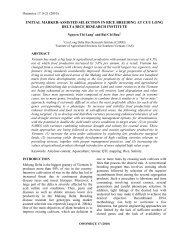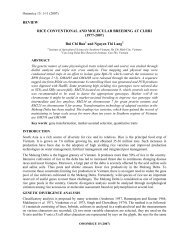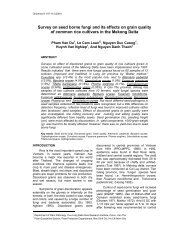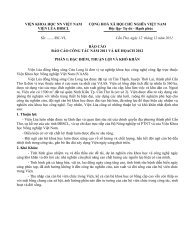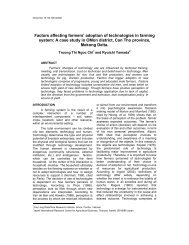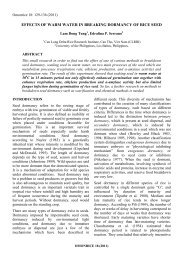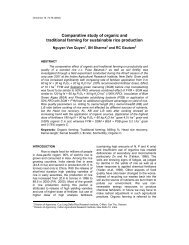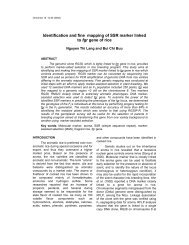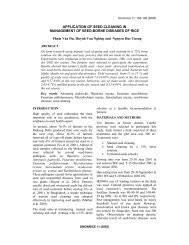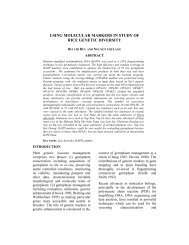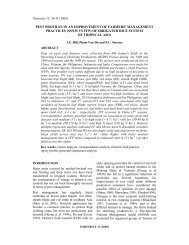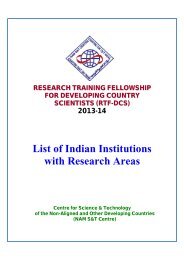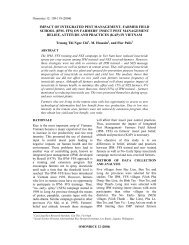BIOCONVERSION OF PADDY STRAW AND BIOFERTILIZER FOR ...
BIOCONVERSION OF PADDY STRAW AND BIOFERTILIZER FOR ...
BIOCONVERSION OF PADDY STRAW AND BIOFERTILIZER FOR ...
Create successful ePaper yourself
Turn your PDF publications into a flip-book with our unique Google optimized e-Paper software.
66<br />
Tran Thi Ngoc Son et al.<br />
build up of organic carbon is due to application of<br />
composted paddy straw combined with<br />
biofertilizer + 25 kg N/ha of inorganic nitrogen. It<br />
was recorded from 0.034 to 0.176 % equally to<br />
0.909 to 6.041 % as compared to farmers’ practice<br />
model. This may be due to inorganic fertilizer<br />
supplying the needed energy and nutrient for the<br />
decomposition of complex organic reserves and<br />
rapid multiplication in the soil microbial<br />
population.<br />
Available nitrogen: Marked differences were<br />
observed on soil available nitrogen due to different<br />
practices. The higher soil N value was observed<br />
under recommended model as compared to<br />
farmers’ practice from 5.78 to 19.467 pppm. This<br />
was due to the inherent N content of the<br />
composted paddy straw incorporated and<br />
transformation during composting and after<br />
application into the soil nitrogen fixing bacteria<br />
viz. Gluconacetobacter diazotrophicus,<br />
Bradyrhizobium japonicum. This is in agreement<br />
with the previvious finding of Tran thi Ngoc Son<br />
et al. 2006.<br />
Available P: was also found to be increased to an<br />
extent of 0.38 to 2.18 ppm under recommended<br />
model as compared to farmers’ practice equal to<br />
an increment of 96.46%, 72.73% and 3.49 % in An<br />
Giang, Can Tho and Long An, respectively.<br />
Organic acids released during decomposition of<br />
organic influences the pH from stable complexes<br />
or chelates with cations responsible from P<br />
fixation as well as the phosphate solublizers viz.,<br />
Pseudomonas and in turn, increased P availability<br />
application of biofertilizers significantly reduced<br />
the fixation of added as well as native P, making P<br />
more available to plant. This resut supports the<br />
findings of many workers (Tran thi Ngoc Son and<br />
Ramaswami, 1997; Gyaneshwar, et al., 2002)<br />
Available K: was also found to be influenced by<br />
different cultural practices. It was obtained higher<br />
value to an extent of 4.6 to 7.0 ppm under<br />
recommended model as compared to farmers’<br />
practice. These increments were equal to 12.46%,<br />
6.53% and 8.16 % in An Giang, Can Tho and<br />
Long An, respectively<br />
Table 3. Average soil nutrient availability of crops at 3 sites at harvest stage under different cultural<br />
practices<br />
Parameters Locations An Giang Can Tho Long An<br />
pH RM (1) 4.938 5.07 5.88<br />
FP (2) 4.727 5.29 5.99<br />
(1)-(2) 0.211 -0.22 -0.11<br />
% increase 4.464 -4.159 -1.836<br />
OC (%) RM (1) 3.774 3.948 1.650<br />
FP (2) 3.740 3.772 1.556<br />
(1)-(2) 0.034 0.176 0.094<br />
% increase 0.909 4.666 6.041<br />
N (ppm) RM (1) 27.78 29.53 16.92<br />
FP (2) 16.84 10.063 11.14<br />
(1)-(2) 10.94 19.467 5.78<br />
% increase 64.96 193.5 51.89<br />
P (ppm) RM (1) 4.44 4.94 11.28<br />
FP (2) 2.26 2.86 10.90<br />
(1)-(2) 2.18 2.08 0.38<br />
% increase 96.46 72.73 3.49<br />
K (ppm) RM (1) 63.2 75.0 71.6<br />
FP (2) 56.2 70.4 66.2<br />
(1)-(2) 7.00 4.60 5.40<br />
% increase 12.46 6.53 8.16<br />
Source: Soil Science Department, CLRRI, (1) Recommended model; (2) Farmer’s practice<br />
OMONRICE 16 (2008)



